Uncle Larry had us bring 10 lbs. of coarsely ground pork shoulder with 25% fat (straight from the butcher that morning), garlic water (half a quart of water with an entire head of sliced garlic soaking in it), coarse ground black pepper, coarse salt, and paprika. Typically, Uncle Larry makes his kobas with sweet paprika, but Chef Reiton and I tend to like to spice things up a bit, so for this batch we decided to try 3 parts Hungarian sweet paprika to 1 part Hungarian sharp paprika.
The only other ingredient that we needed were the casings. While at the butcher we picked up a package for $4, wondering why Uncle Larry was saying they were so expensive. When we got to his house, Uncle Larry had a few casings left from the previous year that he had saved, so we decided to use those first.
The preparation of kobas was very, very simple. We dumped the meat and spices into a very large bowl, and I started kneading with my hands. After the spices were very well blended, Chef Reiton slowly poured in the garlic water while straining out the garlic, and I continued to knead the liquid into the meat. We continued to add water and knead until the meat mixture looked full and very moist but not wet. There was no water in the bottom of the bowl when we were ready to press.
Next came the fun part: making the sausages themselves. Uncle Larry went into a back room and came out with a sausage press that had been in the family, he guessed, for about 60 years. His grandfather had been the first to work the press, and now here it sat, still beautifully black, waiting for the family to press yet another batch of delicious kobas. Chef Reiton raised the plate, swung open the bucket, and we dumped in all 10 lbs. of meat.
To keep the casings from sticking to the stuffing nozzle, it is important to give the nozzle a good greasing, so Chef Reiton showed me how to grab a small handful of meat and smear it all over the nozzle. You can see the bowl of soaked and rinsed casings in the bowl, waiting to be stuffed, in the picture below.
After the nozzle was carefully greased, it was time to feed the first casing. Chef Reiton squeezed an inch of sausage out of the nozzle to prevent the casing from tearing on the nozzle edge
then I gingerly slid the beginning of a casing onto the nozzle.
Chef Reiton then showed me how to carefully feed the casing the entire way up the nozzle, squinching it up like a sock, until there was only about an inch or so of casing left hanging off the nozzle.
Once the casing was entirely fed onto the nozzle, I twisted the end to "knot" the casing, then Chef Reiton began to turn the press handle and a new sausage was on its way.
With an entire casing filled, it was time to make the actual links. I laughed to myself as I watched Chef Reiton measure out the links with his hands, squeeze the filling at a stopping point, then twist the sausage to "knot" it off. I was remembering pictures in storybooks from my childhood, pictures of salamis and links of sausages hanging from the ceiling at a deli. As a kid, I never actually saw sausages like that in the store, and the pictures of them fascinated me. Now here I was, making them.
We continued to stuff the casings that Uncle Larry had leftover, slowly filling the pan with link after link of deliciously fat kobas sausages.
We soon ran out of Uncle Larry's casings and turned to the casings that Chef Reiton and I had brought. We pulled the casings out of the salted soaking water, rinsed them--then frowned. If such statements can be made of animal intestines, Uncle Larry's were much more attractive than ours. Ours were clean, but they had nodules that the more expensive ones didn't. Chef Reiton and I decided right then and there: next year, we pay the extra cash, no matter what.
Before I knew it, my kobas experience was over. Uncle Larry made a request to do it again in a few months, and Chef Reiton and I jumped at the offer. While Uncle Larry went upstairs for a minute to rest, we carefully cleaned the family press, dried it, put it back together, then placed it back on its shelf where it would silently sit and wait, ready to create more memories another day.








